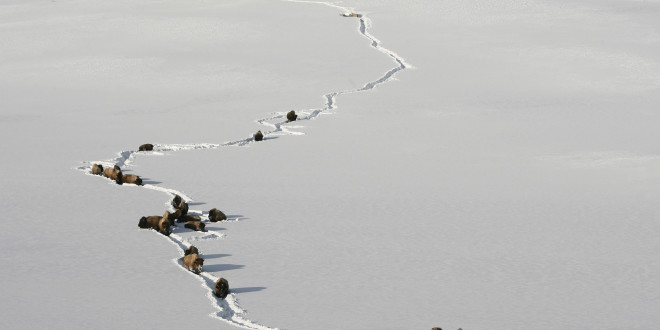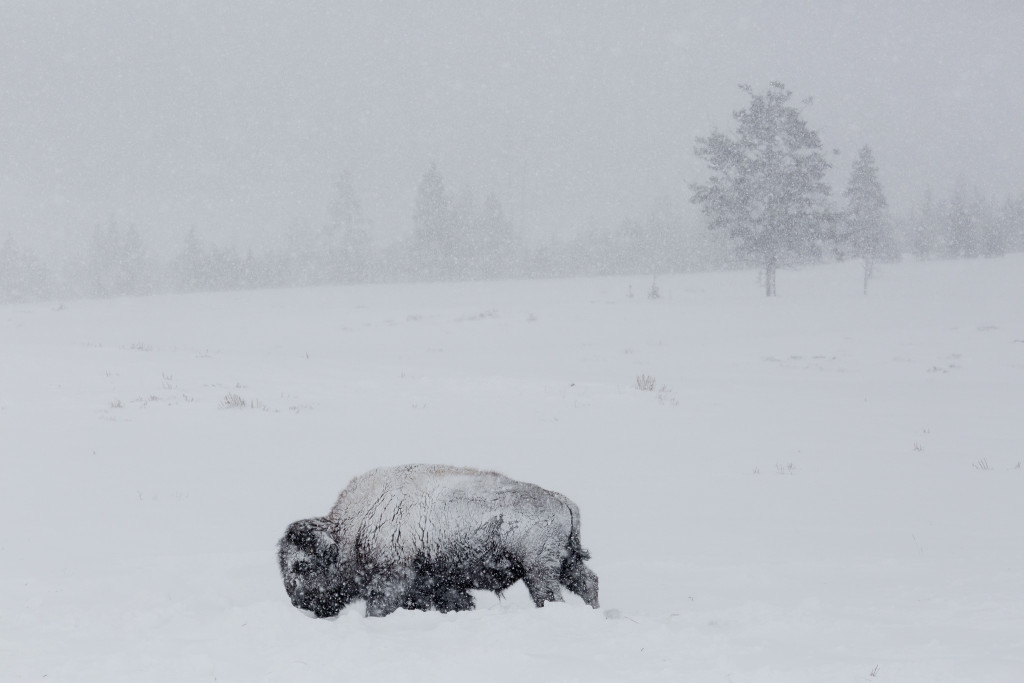Tensions are mounting between Montana lawmakers, environmentalists, and agricultural representatives over bison management around Yellowstone.
During a meeting of the Environmental Quality Council meeting, various council members voiced their opposition to a measure proposed by Governor Steve Bullock, which would permit select bison to roam in “tolerance areas” in parts of Montana north and west of Yellowstone.
One EQC member, state representative Kerry White, went so far as to propose writing a heated letter to the governor opposing the measure. It was put up to a vote: eight in favor, seven against the letter.
Opposition
Concerns over brucellosis transmission led the charge, with stockgrowers and state reps saying allowing bison to roam that far would endanger the state’s cattle economy and provoke an unnecessary stigma, according to KTVH:
“We’re concerned that any additional habitat expansion will provide an increased uncertainty to other states that may lead to import regulations on our cattle,” said Errol Rice from the Montana Stockgrowers Association.
MT State Senator John Brenden agreed with Rice, stating that contracting brucellosis would not only affect the bison population, but the cattle as well.
“We’ve seen it before where Texas and Illinois and Iowa and other places that feed out our cattle don’t want to take them because of the threat of brucellosis and I don’t think we can afford that any more than we can afford to get rid of a coal plant.”
Brucellosis is a concern for the livestock and bison, but also there is a fear of humans contracting the disease.
An idea presented by FWP, bison would eligible for hunting season as a way to control the population. But, if more hunters are coming in contact with diseased bison, the issue arises even more.
“Bruscellosis is a zoonotic disease so it can be transmitted to people. There are a number of veterinarians in the state of Montana and elsewhere that are infected with brucellosis, often times through self inoculation by accident during vaccination,” said State Veterinarian Dr. Martin Zaluski.
“The State of Montana, to my knowledge have had two cases of brucellosis positive human cases. And both of those were associated harvesting wildlife and both of those were in the early 90s.”
To date, there have been no recorded instances of bison to cattle brucellosis transmission. Elk also carry brucellosis, and are more likely to transmit the disease to both cattle and people. Traditionally, brucellosis (called Bang’s Disease/Crimean Fever/Malta Fever in people) was spread to people via unpasteurized milk, improperly cooked meat, or fine transmission i.e. breathing blood vapor in a slaughterhouse or inadvertently infecting oneself through a botched vaccination.
Opponents of Bullock’s decision also cited public safety in their opposition to expanding bison habitat, citing bison’s territoriality and brute strength. They also questioned Montana Fish, Wildlife and Parks’ ability to monitor bison across an area as wide as Bullock’s proposed tolerance areas.
The State’s Case
According to Montana Public Radio, entities such as the Montana Chapter of the Sierra Club and Montana Wildlife Federation have expressed support of Bullock’s decision. And at the EQC meeting, one FWP rep tried to quell concerns regarding how bison will be managed in expanded territory. From MTPR:
Montana Fish, Wildlife and Parks’ Chief of Staff Mike Volesky tried to ease some committee-members’ concerns that the bison population would be allowed to grow unchecked inside these proposed tolerance zones. He emphasized the plan’s adaptive – not uniform and inflexible – management techniques.
“It ranges from hazing – if hazing’s impractical – then we can even shrink tolerance zones. If they go beyond the tolerance zones, we maintain a full array of administrative actions where we can trap them, ship to slaughter, lethal removal if they appear to be heading out of tolerance zones without other options available to us.”
But Volesky says the state’s preferred management tool would be hunting.
“We want to, just like all wildlife, manage these bison through hunting – and sometimes even outside the season. You’ve heard a lot about shoulder seasons and game damage season and that will apply to bison as well. We tried that out a bit last session and it worked out pretty darn well.”
Even Volesky acknowledged, however, that uncertainty would still enter into the equation. From KTVH:
Under Bullock’s plan, bison will be allowed to move to the wilderness area northeast of Gardiner among other areas.
The plan outlines areas where bison are expected to go, but as expressed by some public comments, that may not be an easy thing to do.
“Everybody thinks they know where those bison will move and where they might go and what they’ll do. The fact is, nobody knows that,” said Montana Fish, Wildlife & Parks deputy director Mike Volesky.
Uncertainty of the bison movement was a core issue expressed by multiple people, including lawmakers who already struggle with balancing bison populations within their communities.
“During the winter, we have to be worried about the repeated collisions. We have corrals we put kids in to wait for the bus, things like that,” said MT State Representative Alan Redfield.
Going Ahead
We’ve previously reported on a few developments in the bison management saga. Earlier this week, Yellowstone superintendent Dan Wenk optimistically commented on the Yellowstone bison population, saying “Progress is being made on behalf of the bison,” although adding he expects slaughtering to be the norm until late 2017.
Meanwhile, a new environmental assessment open for public comment is assessing whether to quarantine bison in the Park or at the Fort Peck Reservation in northeastern Montana in order to treat them for brucellosis.
Under federal law, brucellosis-infected bison may not be moved outside of Yellowstone except to designated slaughter facilities. If the quarantine measure is approved, and portions of the herd are declared brucellosis-free, they could potentially be relocated to other parts of the United States to establish/augment wild herds or given to Native American tribes.
Bullock’s decision has not been approved for the current season. The partner agencies under the Interagency Bison Management Plan, which decides bison management around Yellowstone National Park on an annual basis, must vote on the issue. As of writing, there is no indication when IBMP agencies will consider Bullock’s decision.
 Yellowstone Insider Your Complete Guide to America's First National Park
Yellowstone Insider Your Complete Guide to America's First National Park







You must be logged in to post a comment.